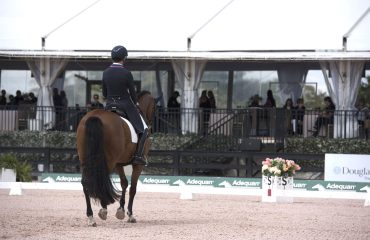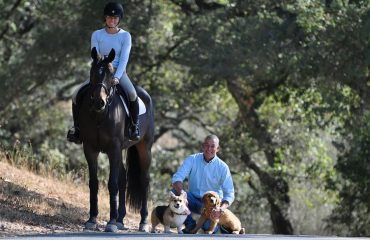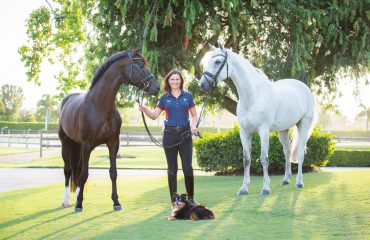Kelly Sigler
Looking Glass Farm
Wagener, South Carolina
Horse development specialist and horsemanship instructor
How did you get started in the horse world?
I have been part of the horse world since I was 4 years old, so 48 years now! I started showing when I was 12. I grew up in South Texas, next door to the King Ranch, so options were more veered to the Western side of things. I was active in 4-H and ranch life. My mare was off the King Ranch, and she was my transportation and my partner in barrel racing and roping, then jumping when I found out about that!
What part do you play in the horse world?
Fast forward from my teenage years to college: My family made me promise that I would not be a horse trainer. Horse trainers didn’t make any money, and my family was very business oriented. They said I could be an accountant or maybe a teacher. There was no way I was going to be an accountant, so I went the teacher route. I got a degree in classics and then went on to get a masters in it. My thesis was on The Breeding, Breaking and Training of the Horse in the Fifth Century. I did a fresh translation on the famous Greek horse trainer Xenophon’s “On Horsemanship.” I then went on to study the development of the horse in Greek and Roman art. After that thesis, I was asked to stay on to complete my doctorate, but I couldn’t stay inside and look at books anymore. I just couldn’t do horses part time and be an academic professionally—so I went on to become a trainer and worked in the eventing world for several years. I then came across a very difficult horse that was a phenomenal jumper, but wouldn’t load into the trailer. This led me to natural horsemanship and a very long journey. I ended up studying directly under the Parellis from 2000 to 2005, going on tour with them, then branching out to become the head trainer of the Biltmore Estate in Asheville, North Carolina. At that time, I was one of the only certified instructors on the East Coast, which kept me very busy. After three years, I decided that I just couldn’t keep up the pace, so I bought a farm outside of Aiken, South Carolina. I have had my own training program ever since, and love it. I have traveled all of the world teaching, but my favorite place is on my farm training horses or taking them to all the incredible horse places and shows that we have here in the Aiken area. Now I have a farm full of beautiful black horses.
 What are your goals for the future with your farm and your horses?
What are your goals for the future with your farm and your horses?
Seven years ago, I visited the island of Menorca, one of Spain’s Balearic islands in the Mediterranean Sea, and met this very special breed of horse—the Menorcans. They are everything that you could imagine in the Black Stallion: jet black, gorgeous, intelligent and personable. I knew then that I loved them, and wanted to bring them to America. Nobody had ever tried to bring this endangered breed to America before. The island that houses most of them is very small—about 30 miles wide—and it is very, very different than the rest of Spain. It is lush and green with little stone walls trickling everywhere. It reminds me of Ireland with sun. My goal was to bring these amazing horses to America, and I have created a little utopia for them here; now, the majority of the Menorcans either live here or spend time here. I have a dedicated office space to the Menorcans and starting to track bloodlines and ownership here.
What do you like about the Menorcan breed?
They are every little girl’s version of the Black Stallion. They are ALL black. They can have a certain amount of white to be registered, but very little. They are kind, intelligent and love people—I adore their disposition. I remember riding one on the trail for the first time and it must have been 30 mile per hour winds, off the coast, straight up these rocks they call hills, and those horses just dug in and did it. I think they must have some billy goat in their bloodlines! They are amazing trail horses and they are amazing movers. The first time I saw one doing “Menorcan” dressage, I was floored. I thought, wow—these horses have the temperament of a foundation Quarter Horse but move more like warmbloods! I was sold. Then when I found out that they were endangered and there were less than 3,000 in the world—I knew I had to get them to the States.
What is your stallion Ganador like?
Ganador is the quintessential gentleman. He loves people but is very respectful. I can ride him by a herd of mares and he might give a slight nicker but that is the most that he will do. He is 6 and has been under saddle for just a year. He will be going to his first show at Training Level. I know that he could start at first, but I want to ensure that he is happy and confident in the ring and don’t want to put a lot of pressure on him.
 What does your breeding program look like?
What does your breeding program look like?
We have two stallions in the country, one colt and four mares. The mares are of good breeding quality and will be approved for breeding by the Stud book in Menorca. Right now, we are open to crossing with approved mares that are not Menorcans.
What’s your favorite thing about what you do?
I get to spend time with horses—who have always been my first love.
What’s your biggest achievement in the horse world?
I could give you a long list of all kinds of things that I have won in dressage and eventing—but that is definitely not my biggest achievement. For me, it is gaining the knowledge, which I thank my mentors for, so that I can help troubled horses and give young horses a good, solid foundation for performance or whatever their partners want to do with them.
What is the best thing about your life?
My relationship with the horses that I work with
Best-kept secret about what you do?
When someone brings a horse to me for training, they can give me whatever back story that they want, but I also let the horse tell me his story. In their training program, I will set the goals with the owner, but the horse always sets the timeline.
For more information, visit kellysigler.com/looking-glass-farm
Photos courtesy of Kelly Sigler













